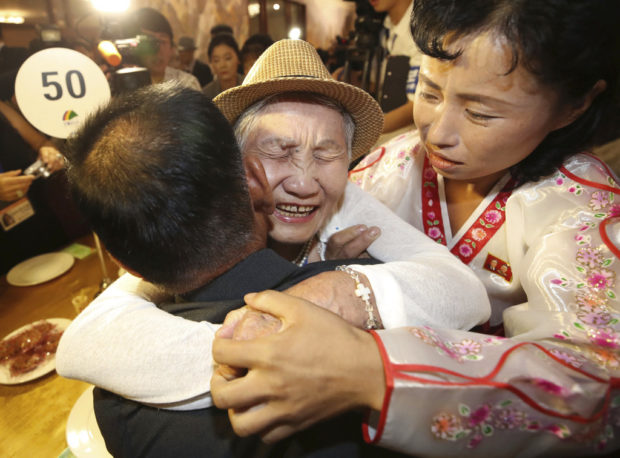Brief Korean reunions bring tears for separated families

South Korean Lee Keum-seom, 92, center, hugs her North Korean son Ri Sang Chol, 71, left, during the Separated Family Reunion Meeting at the Diamond Mountain resort in North Korea on Aug. 20, 2018. AP
SEOUL, South Korea — The 92-year-old South Korean woman wept and stroked the wrinkled cheeks of her 71-year-old North Korean son on Monday, their first meeting since they were driven apart during the turmoil of the 1950-53 Korean War.
“How many children do you have? Do you have a son?” Lee Keum-seom asked her son Ri Sang Chol during their long-awaited encounter at the North’s Diamond Mountain resort.
The emotional reunion came after dozens of elderly South Koreans crossed the heavily fortified border into North Korea to meet with their relatives. The weeklong event, the first of its kind in nearly three years, was arranged as the rival Koreas boost reconciliation efforts amid a diplomatic push to resolve a standoff over North Korea’s drive for a nuclear weapons program.
Hugging the woman he’d last seen as a child, Ri showed his mother a photo of her late husband, who had stayed behind in the North with him as a boy.
Most of the participants in the reunions are in their 70s or older and are eager to see their loved ones once more before they die. Most have had no word on whether their relatives are still alive because they are not allowed to visit each other across the border or even exchange letters, phone calls or email.
Article continues after this advertisementAbout 90 elderly South Koreans, accompanied by their family members, will have three days of meetings with their North Korean relatives before returning to the South on Wednesday. A separate round of reunions from Friday to Sunday will involve more than 300 other South Koreans, according to Seoul’s Unification Ministry.
Article continues after this advertisementDuring Monday’s meeting, many elderly Koreans held each other’s hands and wiped away tears with handkerchiefs while asking how their relatives had lived. They showed photos of family members who couldn’t come to their meetings.
Han Shin-ja, a 99-year-old South Korean woman, was at a loss for words after she reunited with her two North Korean daughters, both in their early 70s. Not knowing their separation would be permanent, she left them behind in the North during the war while fleeing south with her third and youngest daughter.
She could only say “Ah” and “When I fled …” before choking up with tears.
Before this week’s reunions, nearly 20,000 people had participated in 20 rounds of face-to-face reunions since 2000. Another 3,700 exchanged video messages with their North Korean relatives. None of them has had a second chance to see or talk with their relatives.
During the three years since the reunions were last held, the North tested three nuclear weapons and multiple missiles that demonstrated they potentially could strike the continental United States.
North Korea has shifted to diplomacy in recent months. Leader Kim Jong Un and South Korean President Moon Jae-in, a son of North Korean war refugees, agreed to resume the reunions during the first of their two summits this year in April.
South Korea sees the separated families as the largest humanitarian issue created by the war, which killed and injured millions and cemented the division of the Korean Peninsula into the North and South. The Unification Ministry estimates there are currently about 600,000 to 700,000 South Koreans with immediate or extended relatives in North Korea.
But Seoul has failed to persuade Pyongyang to accept its long-standing call for more frequent reunions with more participants. More than 75,000 of the 132,000 South Koreans who have applied to participate in reunions have died, according to the South Korean government.
Analysts say North Korea sees the reunions as an important bargaining chip and doesn’t want them expanded because they give its people better awareness of the outside world. While South Korea uses a computerized lottery to pick participants for the reunions, North Korea is believed to choose based on loyalty to its authoritarian leadership. /ee